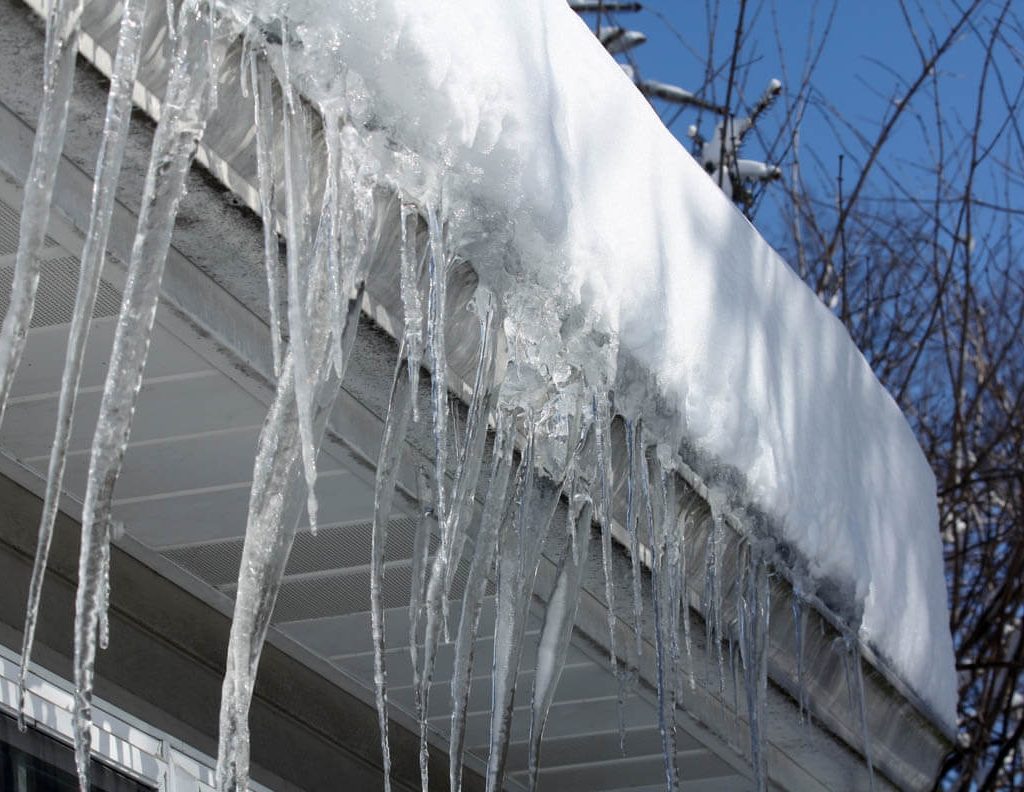As temperatures drop to freezing and snow begins to settle, you may begin to notice narrow spikes of ice across your home’s gutters and roof edges. These are icicles, which typically form when melting snow that refreezes at the edges of your roof. While they may seem harmless, icicles often point to underlying issues like poor insulation, inefficient drainage, or blocked gutters.
In this blog, we’ll explore common reasons for icicles on gutters, how clogged gutters make the problem worse, tips to prevent icicles from forming, and why professional gutter cleaning matters.
Why Do Icicles Form On Gutters?
Icicles typically form when the snow on your roof melts and refreezes near the edges. While they are beautiful, icicles on gutters can be a warning that water is not draining off your roof properly. An ice dam, a buildup of ice along the eaves, often stops melted snow from flowing into the gutters.
Here are some common reasons you may notice icicles hanging from eavestroughs during the winter months:
- Poor Attic Insulation: Warm air escaping through your attic heats the roof, causing snow to melt. As that water trickles down to the colder roof edges, it refreezes and forms icicles. This heat loss can also lead to the formation of ice dams.
- Inadequate Roof Ventilation: Without proper airflow, your attic traps warm air, which speeds up snowmelt. The melted snow then refreezes near the gutters, contributing to icicle buildup.
- Fluctuating Temperatures: Mild days followed by freezing nights create the perfect conditions for icicles to form. As the snow melts and refreezes, water backs up along the eaves, particularly when drainage is blocked.
- Improperly Sloped Gutters: If your gutters don’t slope correctly toward the downspouts, water may get trapped instead of flowing away. In freezing temperatures, that water turns to ice and forms icicles.
- Clogged or Dirty Eavestroughs: If your eavestroughs are filled with leaves or debris, meltwater can’t drain properly. It pools inside the gutter, freezes, and eventually spills over the edge as icicles.
Are Icicles Dangerous?

Some homeowners make the mistake of brushing off icicles as a normal part of winter. Unfortunately, ignoring them can lead to much bigger issues. Here’s why you shouldn’t ignore icicles on gutters:
- Risk of Falling and Injury: Icicles may look harmless, but they can be heavy and sharp. If one breaks off unexpectedly, it can fall on people, pets, or vehicles below, especially if they’re hanging over entrances, driveways, or walkways.
- Added Weight on Gutters: Large icicles hanging from your eavestroughs put significant strain on your gutter system. Over time, this extra weight can cause gutters to sag, pull away from the fascia, or detach completely.
- Structural Stress on Eaves and Fascia Boards: The freeze-thaw cycle that leads to icicle formation can slowly cause water to seep into small cracks around the eaves and fascia boards. When this water freezes and expands, it worsens those cracks, weakens the wood, and can lead to rot or long-term structural damage to the roofline.
- Water Intrusion and Interior Leaks: Water trapped behind an ice dam can seep into your attic or walls, leading to mould, mildew, and expensive water damage.
- Blocked Pathways and Property Hazards: Aside from roof-related risks, icicles that break off can block driveways and walkways or damage property like railings, steps, or landscaping. In some cases, they can also create slippery conditions when they melt, increasing the risk of slips and falls.
Safe Ways to Remove Icicles from Your Home
Removing icicles should always be done with caution. Improper techniques, such as swinging tools at them from below or climbing onto a slippery roof, not only lead to broken gutters and damaged siding but can also result in a serious fall, causing major injury.
The safest way to remove icicles is from the ground using a long-handled broom, extendable pole, or roof rake. Gently tap at the base of the icicle until it loosens and falls away. Always stand off to the side to avoid injury if the ice breaks unpredictably. Avoid using metal tools, which can damage your gutters, and never try to break icicles by hitting the gutters directly.
Another safe way to remove icicles hanging from eavestroughs, especially the ones that are hard to reach, is to melt them gradually. You can fill a sock or cloth bag with calcium chloride and place it across the gutter or roof edge where the icicles have formed. As the product slowly melts the ice, it helps break down both the icicles and any buildup behind them.
Why Professional Gutter Cleaning Matters

When your gutters are clogged, water from melting snow has nowhere to go. Instead of flowing freely through the downspouts and away from your home, it pools inside the gutters. As temperatures drop, that trapped water freezes, creating heavy ice buildup.
Eventually, the ice spills over the edge, forming icicles that hang along your roofline and put extra weight on the gutter system—sometimes leading to cracks, sagging, or even causing the gutters to detach completely. Proper gutter maintenance is crucial in preventing icicles from forming on your eavestroughs.
It’s recommended that you get professional gutter cleaning at least once every spring and fall to ensure proper drainage year-round. However, the frequency of getting professional gutter cleaning may still vary depending on your surroundings. Homes near tall trees or in areas with frequent storms may need more frequent service to prevent buildup and ensure smooth water flow.
At Winducks, our technicians are fully licensed and insured and follow strict safety protocols on every job. We use a 35-foot telescopic vacuum system to reach and clean high or difficult spots. After the main cleaning, we clear out any remaining debris by hand and ensure that all waste is responsibly disposed of using eco-friendly methods.
Trust Winducks to protect your home from expensive winter problems. With a deep and detailed cleaning, we help stop ice from forming, water from backing up, and your gutters from wearing down over time.





